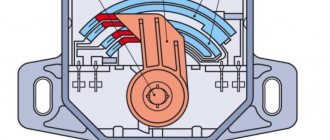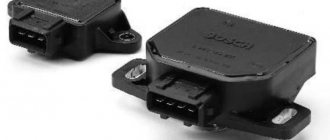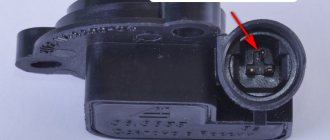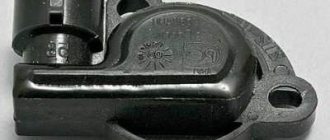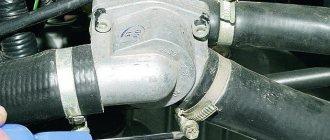Hi all. I have already decided to update all the sensors in the car. After the mass air flow sensor, crankshaft sensor, temperature sensor, there are only 2 left. Reasons for replacement:
The car started well when cold, but if you warmed it up, arrived at your destination, turned it off, and later started it again, then it’s a beard. It simply refused to start by turning the starter as much as it wanted, but if you added a little more gas, it would start, but if you let off the gas it would stall again. That is, the dying of the Idle Air Controller was detected.
Well, let's go to the store. I came and bought a TPD at the same time (it costs a penny, about 165 rubles). I read the box, send an SMS blah blah blah, I send it, the answer is: this is a fake... thoughtful face... how?! I call technical support, the girl answers that this code has already been activated dozens of times throughout Russia. It's sad... I went to the store, talked to the sellers and it turns out everyone is complaining, firstly, the price is 130 rubles lower than Pekarov's (factory price), and secondly, the rod is extended by more than 23 cm and is not made so well. Paid extra, bought it, installed it. At the same time I cleaned the throttle valve.
Try to refrain from products manufactured in Kaluga, and always buy proven parts.
The throttle position sensor (TPS) is one of the elements of the electronic control system (ECM) of the injection engine of VAZ 2108, 2109, 21099 vehicles.
Purpose of the throttle position sensor
TPS is designed to control the position of the throttle valve. The control unit takes the signal from the position sensor into account when calculating the amount of fuel required by the engine at the moment. The system uses TPS readings in start-up, operating and power modes, as well as when determining idle and forced idle.
On VAZ 2108, 2109,21099 cars a film-resistor throttle position sensor is installed. Inside it are resistive tracks and a slider moving along them. The slider is connected to the throttle shaft. As the slider moves along the tracks, the resistance changes and, accordingly, the voltage supplied to the control unit. That is, it is a potentiometric type resistor.
The sensor has three outputs: one control unit supplies a voltage of 5V, the other is connected to ground, and the third sends a changing signal about the throttle position to the unit.
Location by car
The throttle position sensor on the engines of VAZ 2108, 2109, 21099 cars is located on the throttle body, on the throttle axis.
Operating principle of TPS
When the throttle valve is closed, the throttle position sensor supplies a voltage of 0.35 - 0.7 V to the controller. When the throttle valve is opened, the slider inside the TPS begins to move along its resistor tracks. The voltage supplied from the sensor to the controller increases. Based on its value, the controller determines the degree of opening of the throttle valve and accordingly enriches or leans the fuel mixture (the more the valve is open, the higher the enrichment). With the throttle valve fully open, the voltage produced by the TPS is 4.05 - 4.75V.
When the throttle is opened more than 90%, the controller stops supplying fuel to the cylinders. This mode is usually used when purging cylinders with the gas pedal fully depressed and the crankshaft rotated by the starter.
A fully closed throttle signals the controller to enter idle mode.
When you sharply press the gas pedal and, accordingly, a sharp jump in voltage supplied to the controller, there is an additional increase in fuel supply to the engine (imitation of a carburetor accelerator pump).
TPS malfunctions
Failure of the throttle position sensor most often leads to failures and jerks in engine operation, since the controller receives an incorrect signal about the throttle position and, accordingly, incorrectly calculates the fuel supply. In addition, a faulty TPS is one of the reasons for increased idle speed (sometimes freezing at 1500-2000 rpm), interruptions when releasing the gas and changing gears, deterioration in vehicle dynamics, and increased fuel appetite of the engine.
A complete failure of the sensor leads to a transition to the backup mode of operation of the engine management system and the “Check Engine” lamp on the instrument panel lights up and the error is entered into the controller’s memory. In this case, the fuel supply is calculated by the controller based on the readings of the mass air flow sensor, the TPS data is replaced by readings from the backup table. The idle speed is not regulated and is set within 1500 rpm (120 steps of the idle speed control).
Most often, in the TPS, the resistive layer of the tracks along which the slider moves crumbles. Therefore, it is advisable to change it to a contactless TPS.
Applicability of the throttle position sensor on VAZ 2108, 2109, 21099 cars
On VAZ 2108, 2109, 21099 cars with injection engines and controllers of all types, a throttle position sensor 2112-1148200 manufactured by GM or its domestic analogues is used.
Notes and additions
A resistor is an element of an electrical circuit that creates resistance to the flow of electric current.
Potentiometric resistor - converts changing resistance (as the contact moves along the resistor tracks) into an output voltage of different values.
Throttle position sensor (TPS) VAZ 21083, 21093, 21099
The throttle position sensor (TPS) is one of the elements of the electronic control system (ECM) of the injection engine of VAZ 21083, 21093, 21099 vehicles.
Purpose of the throttle position sensor
TPS is designed to control the position of the throttle valve. The control unit takes the signal from the position sensor into account when calculating the amount of fuel required by the engine at the moment. The system uses TPS readings in start-up, operating and power modes, as well as when determining idle and forced idle.
Throttle position sensor device
On VAZ 21083, 21093,21099 cars a film-resistor throttle position sensor is installed. Inside it are resistive tracks and a slider moving along them. The slider is connected to the throttle shaft. As the slider moves along the tracks, the resistance changes and, accordingly, the voltage supplied to the control unit. That is, it is a potentiometric type resistor.
The sensor has three outputs: one control unit supplies a voltage of 5V, the other is connected to ground, and the third sends a changing signal about the throttle position to the unit.
Location by car
The throttle position sensor on the engines of VAZ 21083, 21093, 21099 cars is located on the throttle body, on the throttle axis.
Operating principle of TPS
When the throttle valve is closed, the throttle position sensor supplies a voltage of 0.35 - 0.7 V to the controller. When the throttle valve is opened, the slider inside the TPS begins to move along its resistor tracks. The voltage supplied from the sensor to the controller increases. Based on its value, the controller determines the degree of opening of the throttle valve and accordingly enriches or leans the fuel mixture (the more the valve is open, the higher the enrichment). With the throttle valve fully open, the voltage produced by the TPS is 4.05 - 4.75V.
When the throttle is opened more than 90%, the controller stops supplying fuel to the cylinders. This mode is usually used when purging cylinders with the gas pedal fully depressed and the crankshaft rotated by the starter.
A fully closed throttle signals the controller to enter idle mode.
When you sharply press the gas pedal and, accordingly, a sharp jump in voltage supplied to the controller, there is an additional increase in fuel supply to the engine (imitation of a carburetor accelerator pump).
TPS malfunctions
Failure of the throttle position sensor most often leads to failures and jerks in engine operation, since the controller receives an incorrect signal about the throttle position and, accordingly, incorrectly calculates the fuel supply. In addition, a faulty TPS is one of the reasons for increased idle speed (sometimes freezing at 1500-2000 rpm), interruptions when releasing the gas and changing gears, deterioration in vehicle dynamics, and increased fuel appetite of the engine.
A complete failure of the sensor leads to a transition to the backup mode of operation of the engine management system and the “Check Engine” lamp on the instrument panel lights up and the error is entered into the controller’s memory. In this case, the fuel supply is calculated by the controller based on the readings of the mass air flow sensor, the TPS data is replaced by readings from the backup table. The idle speed is not regulated and is set within 1500 rpm (120 steps of the idle speed control).
Most often, in the TPS, the resistive layer of the tracks along which the slider moves crumbles. Therefore, it is advisable to change it to a contactless TPS.
Applicability of the throttle position sensor on VAZ 21083, 21093, 21099 vehicles
On VAZ 21083, 21093, 21099 cars with injection engines and controllers of all types, a throttle position sensor 2112-1148200 manufactured by GM or its domestic analogues is used.
Notes and additions
A resistor is an element of an electrical circuit that creates resistance to the flow of electric current.
Potentiometric resistor - converts changing resistance (as the contact moves along the resistor tracks) into an output voltage of different values.
Source
Location and principle of operation of the meter
The sensor is installed on the throttle valve block and is mechanically connected to its axis. Thanks to this, the device is able to solve 3 problems:
- inform the controller at what angle the throttle is currently open;
- signal that the air supply is completely closed (the driver has released the accelerator pedal);
- monitor the speed at which the damper opens.
Based on this information, the electronic powertrain control unit (ECU) makes a decision to increase or decrease the fuel supply and fuel injection for intense acceleration when the gas pedal is sharply pressed.
Reference. Two types of TPS are installed on cars: resistive and non-contact. The first ones are cheaper and therefore are found on all budget cars. The latter are more reliable and more expensive, and are installed on cars of medium and high price categories.
The operating algorithm of the resistive sensor is as follows:
- At idle, the damper is closed and air flows into the engine through a separate channel. The voltage at the output of the device does not exceed 0.5 volts; the controller supplies fuel to maintain engine idle speed.
- When the driver presses the gas pedal, the sensor slider moves along the resistive film. The resistance of the electrical circuit into which the device is connected in series decreases.
- The ECU “sees” the increase in voltage in the meter circuit, makes a calculation, prepares the air-fuel mixture in the required quantity and supplies it to the cylinders. The maximum voltage at wide open throttle is about 4.5 V.
- When the driver sharply presses the accelerator pedal, the controller notes a similar voltage surge and delivers a portion of the enriched mixture for dynamic acceleration.
Note. The operating voltage values are indicated for a common Russian car - VAZ 2110.
The non-contact throttle position sensor functions identically. The difference lies in the method of influencing the electrical circuit. A resistive device changes resistance using a slider moving across the film, while a non-contact device changes resistance due to the magnetic-resistive effect. Thanks to this principle of operation, the TPS lasts much longer and does not create problems for the owner of the car.
VAZ 2109 injector throttle position sensor
1200 rub. for the photo report
We pay for photo reports on car repairs. Earnings from 10,000 rubles/month.
Write:
To replace the TPS sensor on a VAZ 2108, 2109, 21099, you will need a Phillips screwdriver. We inspect the engine and find the location of the throttle sensor - it is located on the side of the throttle pipe and is connected to the throttle axis - the video clearly shows its location.
The throttle position sensor on injection versions of VAZ 2109-2108 engines performs the function of controlling the fuel supply. Depending on how much the gas pedal is pressed, this sensor sends a signal to the control unit, and it, in turn, decides how much fuel to supply.
Changing this part is quite simple, but you will definitely need a very short screwdriver for this. Although I had two sets of tools, I still had to buy a separate screwdriver to make the replacement:
Electronic engine control unit
The engine control unit is responsible for the operation of almost the entire car. In this part, hundreds of processes are calculated, all readings from sensors installed on the car are processed. Many people call the ECU a “computer” and it’s impossible to disagree with this. The unit, receiving readings from the sensors, processes them and controls the engine, adjusting the supply of fuel and air to the combustion chamber.
Why is it needed?
The throttle position sensor is responsible for determining the current throttle position. Depending on this, the fuel supply system changes the amount of fuel supplied under one or another operating mode of the power unit.
If problems arise with it, you can contact a service station so as not to waste your energy and nerves. But in practice, changing the TPS yourself is quite simple, plus you will save a decent amount of money.
The desired regulator is located on the side of the throttle pipe on the throttle valve axis.
Regulator location
Features of work
The TPS is essentially a variable resistor, one output of which is supplied with 5 Volt power. The second contact is connected to ground, and the third is connected to the controller.
When you press the gas pedal, the voltage changes. The sensor monitors the output voltage on the controller, thereby regulating and monitoring the quality of the supplied air-fuel mixture. This directly depends on the opening angle of the damper itself.
If for some reason this regulator fails, a catastrophe will not occur, since another sensor, the mass air flow sensor, will temporarily take over its functions.
This does not mean at all that the TPS can not be changed. Each regulator has its own functions, so there is no point in transferring the tasks of the TPS to the MAF.
Delivery by transport company
Delivery by one of the transport companies with a representative office in your city. Delivery time: 2-10 days depending on the distance of your locality from Togliatti. The most convenient and fastest way to deliver orders of different sizes. Delivery cost from 250 rub. depending on weight and delivery distance.
Orders are sent by transport companies based on 100% payment for the order.
We cooperate with:
PEC
Find the nearest representative office, track the cargo and calculate the cost of delivery
pecom.ru
Business Line
Find the nearest representative office, track the cargo and calculate the cost of delivery
dellin.ru
Baikal Service
Find the nearest representative office, track the cargo and calculate the cost of delivery
baikalsr.ru
Energy
Find the nearest representative office, track the cargo and calculate the cost of delivery
nrg-tk.ru
GTD (formerly KIT)
Find the nearest representative office, track the cargo and calculate the delivery cost
https://gtdel.com
Zheldor expedition
Find the nearest representative office, track the cargo and calculate the cost of delivery
jde.ru
SDEK
Find the nearest representative office, track the cargo and calculate the cost of delivery
edostavka.ru
If you do not know which method of delivery of goods will be more convenient for you to use, then place an order for any method, and when our manager contacts you to confirm the order, he will recommend you the most optimal method in terms of cost and delivery time for your order. No matter what region of Russia you live in, there is always a profitable and convenient delivery method for you.
The lead time for placing orders with “In Stock” items is 1-4 business days after receipt of funds (orders are not generated on Saturday and Sunday). Lead time for orders including painting services: 3-8 business days. The lead time for placing orders and “made to order” items is 14 days; you can check with the manager for more detailed information.
Delivery is carried out throughout Russia and the CIS. Orders for pickup are placed on the website, the processing time is on average 1-4 business days, after the items arrive at the pickup point, the manager will notify you when you can receive your order.
Attention! Regardless of which delivery method you choose, check the integrity of the goods and packaging upon receipt of the cargo (parcel).
ATTENTION! All fragile goods (headlights, plastic products, glass, etc.), by default, are sent in additional paid packaging from TK. If you take responsibility for integrity, we can ship without it. To do this, you need to make a note in the comments when placing your order. For additional information, please contact the managers.
To improve the quality of customer service, video recording of order packaging is performed.
Malfunctions
There are several telltale signs of trouble that may indicate that there is a problem with the throttle valve control.
- High idle speed;
- When the gear is switched off, the engine may stall;
- When the car picks up speed, the car jerks and jerks are felt;
- Acceleration dynamics deteriorate significantly;
- Floating speed occurs at idle.
It should be noted that similar symptoms may also be characteristic of the failure of other components - the idle speed control or the ignition module, for example. Therefore, you first need to check the TPS.
Checking the status of the regulator
Next, let's talk about how you can check this throttle valve sensor. The event is necessary because it allows you to understand whether all the troubles are really due to it, or whether the problems arose due to the failure of other elements of your car.
It’s not uncommon for novice car owners to make hasty conclusions based on the primary signs of a breakdown. This results in unnecessary repair work and costs.
To check the current status of the throttle position sensor you need to:
- Measure the voltage at the output of the slider, turning on the ignition and opening the idle contacts;
- If the test shows that the voltage is more than 0.7 volts, then the sensor has indeed failed;
- Open the damper completely. In normal condition, voltage readings should be no more than 4 volts;
- Measure the variable resistor for resistance;
- To do this, connect an ohmmeter or a multimeter in ohmmeter mode to the power supply and output;
- Slowly begin to turn the throttle;
- At the same time, monitor the readings on the device;
- If, as the damper opens, the resistance also changes slowly, then the unit is working properly.
If you find during the test that the sensor is faulty, you only need to replace it. It cannot be repaired.
The resistive layer along which the slider moves wears off over time due to friction. Because of this, the regulator begins to produce incorrect data, the characteristics of the supplied mixture change, and engine performance deteriorates.
Disabling the regulator
Diagnostics with an autoscanner
First option
We connect the ELM to the diagnostic connector. Turn on the ignition and connect to the ECU. I will use OpenDiag. In other programs the sequence of actions is the same; the names of the parameters should not differ much from my example.
Go to the “Select ECU parameters” menu. Find “Throttle Position” and put a checkmark next to it.
When the gas pedal is not pressed and the engine is not running, the throttle should be closed, that is, show 0%. If they change on their own without your participation, the sensor is faulty.
Source
Replacement
In fact, changing this sensor is insanely easy. So don't rush to send your car to a service station. Everything can be done with your own hands, the quality will not suffer from this.
- To remove the throttle position sensor, you first need to find it.
- As we have already noted, the desired unit is located on the side of the throttle pipe on the throttle valve axis.
- Having found the element, pick up a shaped screwdriver.
- Using this simple tool, unscrew a couple of bolts that hold the device.
- Pay special attention to the gasket that is available under the old regulator. We do not recommend using it again; it is better to immediately buy a new one. Often the gasket is already included with the throttle sensor itself.
- After removing the old sensor, you can slightly clean the place where it is installed if there is dirt there.
- Next, a new sensor is installed along with a new foam gasket and the bolts are tightened.
- Try to tighten the fasteners as far as possible, otherwise the new throttle sensor will quickly lose its effectiveness. The work will have to be done again.
- There is no need to make any adjustments after replacement.
- The zero mark on the controller will determine that the throttle is completely closed.
Throttle sensor malfunctions
Malfunctions of the throttle sensor lead to unstable operation of the car engine. That the TPS is not working correctly can be understood by the following signs: unstable idle, decreased car dynamics, increased fuel consumption and other similar troubles. The main sign that the throttle position sensor is faulty is jumping speed. And the main reason for this is wear on the contact tracks of the throttle valve sensor. However, there are a number of others.
Checking the throttle position sensor is quite simple, and even a novice car enthusiast can do it. To do this, you only need an electronic multimeter capable of measuring DC voltage. If a sensor fails, repairing it is most often impossible, and the device is simply replaced with a new one.
Idle speed control
The idle speed sensor is a DC motor with a “cap” on its shaft that acts as a valve. This valve closes the channel in the throttle valve, thereby opening or closing the air supply to idle. The IAC only works at idle and at high speeds, when the throttle valve is open, it does not participate.
Location
The VAZ 2109 idle speed regulator is located on the throttle valve on the reverse side.
Signs of malfunction:
Signs of a malfunctioning throttle position sensor
Before moving on to describing the symptoms of a TPS failure, it makes sense to briefly dwell on the question of what the throttle position sensor affects. It is necessary to understand that the main function of this sensor is to determine the angle at which the damper is rotated. The ignition timing, fuel consumption, engine power, and dynamic characteristics of the car depend on this. Information from the sensor enters the electronic engine control unit, and based on it, the computer sends commands about the amount of fuel supplied and the ignition timing, which contributes to the formation of an optimal air-fuel mixture.
Accordingly, malfunctions of the throttle position sensor are expressed in the following external signs:
- Unstable, “floating” idle speed.
- The engine stalls while changing gears, or after changing from any gear to neutral speed.
- The engine may stall randomly when idling.
- While driving there are “dips” and jerks, in particular during acceleration.
- The engine power is noticeably reduced, and the dynamic characteristics of the car drop. This is very noticeable in terms of acceleration dynamics, problems when driving the car uphill, and/or when it is heavily loaded or towing a trailer.
- The Check Engine light on the dashboard activates (lights up). When scanning errors from the ECU memory, the diagnostic tool shows error p0120 or another related to the throttle position sensor and its malfunction.
- In some cases, there is increased fuel consumption by the car.
It is worth noting here that the signs listed above may also indicate problems with other engine components, in particular, a malfunction of the throttle valve. However, during the diagnostic process, it makes sense to also check the TPS sensor.
Causes of TPS malfunction
There are two types of throttle position sensors - contact (film-resistive) and non-contact (magnetoresistive). Most often, it is the contact sensors that fail. Their work is based on the movement of a special slider along resistive tracks. Over time, they wear out, which is why the sensor begins to provide incorrect information to the ECU. So, the reasons for the failure of a film-resistive sensor may be:
- Loss of contact on the slider. This can be caused either simply by physical wear or by a broken tip. The resistive layer may simply wear out, causing the electrical contact to also disappear.
- The linear voltage at the sensor output does not increase. This situation may be caused by the fact that the base coating has worn off almost to the base in the place where the slider begins to move.
- Wear of the slider drive gears.
- Broken sensor wires. These can be both power and signal wires.
- A short circuit has occurred in the electrical and/or signal circuit of the throttle position sensor.
How to Determine a Malfunctioning Throttle Sensor
Checking the TPS itself is simple, and all you need is an electronic multimeter capable of measuring DC voltage. So, to check the TPS malfunction, you need to follow the algorithm below:
- Turn on the car's ignition.
- Disconnect the chip from the sensor contacts and use a multimeter to make sure that the sensor is receiving power. If there is power, continue checking. Otherwise, it is necessary to “ring” the supply wires in order to find the break point or another reason why the voltage to the sensor is not suitable.
- Set the negative probe of the multimeter to ground, and the positive probe to the output contact of the sensor, from which information goes to the electronic control unit.
- When the throttle is closed (corresponds to the accelerator pedal being fully depressed), the voltage at the sensor output contact should not exceed 0.7 Volts. If you open the throttle completely (fully depress the accelerator pedal), then the corresponding value should be at least 4 Volts.
- Next, you need to manually open the damper (rotate the sector) and at the same time monitor the multimeter readings. They should rise smoothly. If the corresponding value rises abruptly, this indicates that there are worn spots in the resistive tracks, and such a sensor must be replaced with a new one.
Owners of domestic VAZs are often faced with the problem of TPS malfunction due to the poor quality of the wires (in particular, their insulation) with which these cars are standardly equipped from the factory. Therefore, it is recommended to replace them with higher quality ones, for example, produced by PES/SKK CJSC.
And, of course, it is necessary to perform a check using the OBDII diagnostic tool. A popular scanner that works with most cars is Scan Tool Pro Black Edition . It will help you find out exactly the error number and see the operating parameters of the throttle valve, and will also determine whether the car still has problems, possibly in other systems.
The most common error associated with the throttle position sensor is code P0120 and stands for “Throttle position/pedal position sensor/switch “A” circuit malfunction.” Another possible error p2135 is called “Mismatch of readings from sensors No. 1 and No. 2 of the throttle position.” The following codes may also indicate incorrect operation of the remote control or its sensor: P0120, P0122, P0123, P0220, P0223, P0222. After replacing the sensor with a new one, it is necessary to erase the error information from the ECU memory.
In the diagnostic application, the scanner will make it possible to see the data coming from the sensor in real time. When moving the damper, you need to look at the readings in volts and the percentage of its opening. If the damper is in good condition, the sensor should produce smooth values (without any jumps) from 03 to 4.7V or 0 - 100% with the damper fully closed or open. It is most convenient to view the operation of the TPS in graphical form. Sharp dips will indicate wear of the resistive layer on the sensor tracks.


